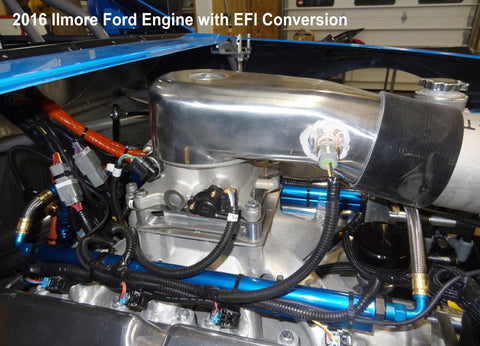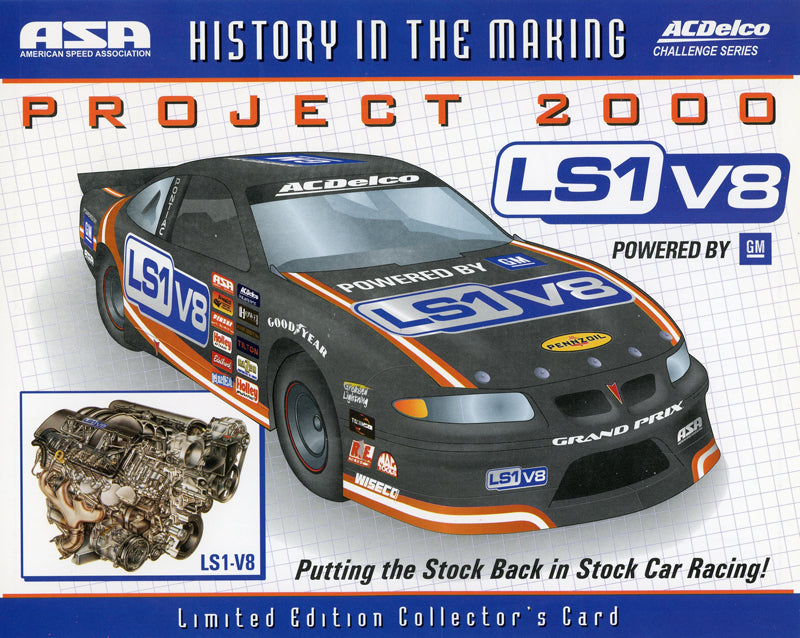Your Cart is Empty
Please call or email howesales@howeracing.com if you have issues placing international orders.
Please call or email howesales@howeracing.com if you have issues placing international orders.
The year 2000-2004: Howe Racing Enterprises worked with GM Racing in 1999 to develop a low-cost, high-performance racing engine for the American Speed Association. When testing is complete, GM produces hundreds of engines for ASA. The ASA engine is a 5.7L LS1 Corvette built at the GM Romulus engine assembly plant in Michigan. The engines are "upfitted" for racing by Katech Performance. Katech Technicians Kevin Pranger and Steve Moore provide track support. Katech Technicians Kevin Pranger and Steve Moore provide track support. In 2002 ASA Tech Director Joe Balash disqualified the first competitor for tampering with an ASA engine. Rookie standout Scott Lagasse Jr. wins his first ASA race at Kentucky Speedway in 2004 with the ASA engine.

2007: A Dutch racing organization contacts Howe to create a new racing class in the Netherlands based on U.S. Stock Cars; the class is called DNRT V8. Howe uses engines built to the ASA formula by Schwanke Engines in Minnesota using a 6.0L LS2. Howe delivers only 13 cars to the Netherlands. The performance exceeds expectations, but Euro customers fail to connect with the appearance of the "NASCAR-ish" Five Star stock car bodies.

2008-10: Swedish racing team owners Hans Emeren and Tony Bryntesson contacted Howe about adapting the DNRT-V8 chassis into a "Bumblebee" Camaro for the Camaro Cup Series in Scandinavia. The car used a GM ZZ4 crate engine. The new car was an instant hit that grew to 60 cars in less than two years. In 2010 Howe built a demo version of the Camaro Cup car for the U.S. with a Schwake LS3 engine. Not knowing where to sell the car, Howe presents it to club racers at the Autobahn Country Club in Joliet, Illinois, where they had tested the Camaro Cup car a year prior with Swedish driver Nic Jönsson. Club member Britt Casey Sr. drives the car to victory in an exhibition race against a group of club Porsches.


2011: Trans-Am has added the GT America class to bolster shrinking entries in the TA class. The GT America cars that were running with Trans Am in 2011 consisted of old ASA cars and three new Howe Camaros driven by Greg Rodgers, Bob Stretch, and Tom Sheehan. Someone renames the class "TA2," and the name sticks. Jim Derhaag organizes a small group of investors to take over the operation of Trans-Am from SCCA. Derhaag invites Chas Howe to Road America to discuss the expansion of the TA2 class with the new Camaro and the LS3 engine. As TA2 grows in popularity, the supply of old LS-ASA engines dries up.
Series Technical Director Kirk Ready allows the LS3 with an intake restrictor to bring the 525 hp down to the 470 hp of the ASA engine.
Cost: $13,500

2012: John Clagett replaces Randy Hembrey as Trans Am President. Mike Miller joins Trans-Am as a TA2 driver and team owner but becomes a board member and series majority shareholder soon after. Miller has a long relationship with Katech and leads efforts to add Katech as an approved engine builder. Kevin Pranger builds the Katech engines for Miller. By the end of 2012, no cars are running an LS1.
Cost: $16,000.

Late 2012: Corvette team driver Jan Magnusson is also a Camaro Cup team owner. Magnusson discusses building a Camaro Cup engine with GM Racing. Howe begins work with GM Racing and Swedish Camaro Cup organizer Tony Bryntesson on a production-based racing engine. Former Katech technician Steve Moore leads the GM development at the GM Performance Lab in Wixom, MI. The finished engine is installed in a Howe test car and taken to NOLA Motorsports Park in December. Magnusson and a young Cameron Lawrence alternate as test drivers. Following the test, the engine goes into production as the LS-CCR (Camaro Cup Racing). Howe would sell more than 160 of the engines worldwide.



2013:The 2013 Ford Coyote engine is too wide to fit a TA2 chassis. Tom West competes with the first-gen five Mustang body using the same LS3 engine as the Camaro. Michigan engine builder Phil Harper proposes a narrower, 5.7L pushrod Ford built with a Dart aluminum block and a carburetor. Kirk Ready approves the Ford with an intake restrictor. In August, Trans Am added Mike Cope and three others as approved car builders for TA2. Cope installed the first Harper Ford engine in a car driven in 2014 by former ASA car owner Ron Keith.
Costs: Chevy $16,000, Ford $14,500


2014: At Homestead Speedway, Chas Howe offers the LS-CCR Engine to Trans-Am, but Jim Derhaag asks for more than GM offers, and Howe withdraws the offer. At Mid Ohio, Mike Miller and Dodge SRT debut the Dodge Challenger with an aluminum block, 6.3L EFI Hemi Engine built by Arrow Performance.
Average Cost: $17,500.


2015-17: The class grows, but increased competition raises tensions over perceived imbalances. Ilmor Racing Engines buys out Phil Harper, taking over production of the TA2 Ford engine. Trans-Am approves the expensive Dailey oil pans for all engine models after discovering them on some Katech Chevys. Late in 2016, Ricky Brooks became the new TA2 Technical director. Brooks takes engines to a neutral dyno facility in Tennessee and adjusts the restrictor sizes. Following the purchase of Arrow engines, Prefix Corporation took over as the supplier of the TA2 Hemi engine and eventually became an approved engine builder for the Chevy and Ford engines. Trans-Am mandates a standard ECU made by series sponsor AEM and changes the Ford from a carburetor to EFI.

Mike Miller sells his race team to Joe Stevens and his series ownership to Tony Parella. Tony Ave and Jim Derhaag also sell their shares to Parella, giving the new owner complete control. 2017 TA2 Champion Gar Robinson travels to Australia to compete at Bathurst in a TA2 Challenger with an LS-CCR engine.
Cost: Chevy $20,000, Dodge and Ford $24,000.


2018: GM discontinues the LS-CCR due to model changeover to the LT1 engine causing Howe to solicit bids from Katech, Wegner, and Prefix. Howe excepts the offer from Prefix. Steve Moore works with Rick Talbot at Prefix to move the LS-CCR engine, renaming it the "Prefix Global Engine." Howe orders 24 Global engines sending the first engines to Thailand and Australia.
Ilmor pulls out of Trans Am when Race Winning Brands buy out dart Machinery. The sale of Dart causes a stop in the production of Ford blocks. Dodge also phases out the aluminum 392 blocks. The shortage of parts for the Ford and Dodge spikes the price of each. Trans-Am begins looking for a new lower-cost engine from Katech, Prefix, and Wegner. A Wegner 5.3L carbureted engine is installed in the car of Rafa Matos and competes in the last two races at Cota and Daytona. Plans to approve the Wegner engine for 2019 fall apart in December due to cost and logistical problems. Trans-Am contacts Howe with interest in the Prefix Global Engine.
Cost: Chevy $23,000, Ford $34,000, Dodge $28,000.

2019:A meeting on 1/2/19 at Prefix Corporation includes Trans Am, Howe, and Prefix representatives. All agree that the Global engine is to be produced exclusively by Prefix. A track test would follow independent dyno testing by Trans Am. Howe, Prefix, and SLR racing sponsor a track test of the Prefix Global engine at Sebring on January 29-30. Scott Lagasse Jr. is the driver for the test.
Following the test, Ricky Brooks reviews the results and selects a restrictor to match the new engine to the existing options. Finally, John Clagett renames the engine "TA2 Choice" and plans the unveiling for Sebring.

The engine is essentially a Chevy 2012 Corvette with an SUV intake and a Kinsler manual throttle body. The factory 2012 Corvette oil pan required the engine to sit nearly 2" higher in the chassis. Because Trans Am uses a higher g-force Pirelli radial tire, it struggles with inconsistent oil pressure and venting. Even with the few bugs, the Choice proves itself competitive at a reduced cost. The last surviving component from the GM Project 2000 is the ASA spec camshaft.
Cost: $16,879.

2020:Prefix raises the price of the Choice engine to address rising component costs and track support. The engines remain competitive, but falling lap time further exceeds the factory oiling systems. The China virus abbreviates the season, and by the end, Prefix drops out as an engine supplier due to changes in their core business. Trans Am opens up the engine formula to all approved engine builders and works with Katech Engines to improve the oiling system.
Choice Chevy Cost: $23,200. Chevy Built Cost: $28,000. Ford $34,000, Dodge $34,000.

2021:Trans Am allows a Daily oil pan and lowers the minimum crankshaft height rule. The Choice engine becomes the preferred engine option, and Katech is the top supplier of the Choice engine. Choice engines win 9 out of 12 TA2 races and the top three places in championship points.
Choice Chevy Cost: $26,795 without harness or ECU. Ford $36,000, Dodge Unknown

